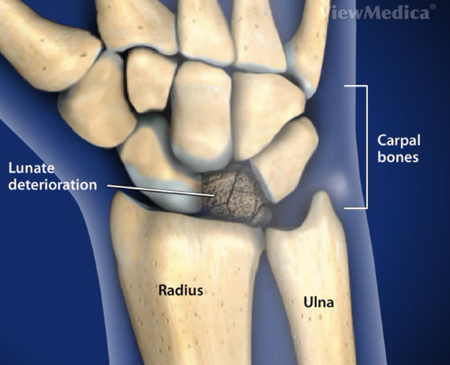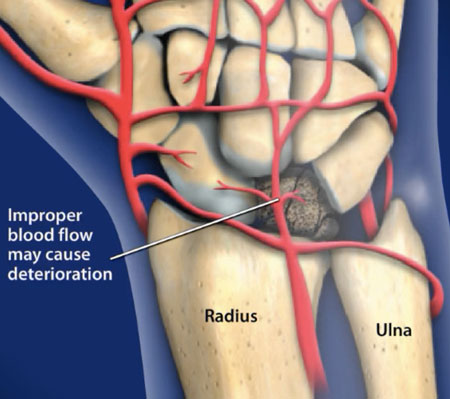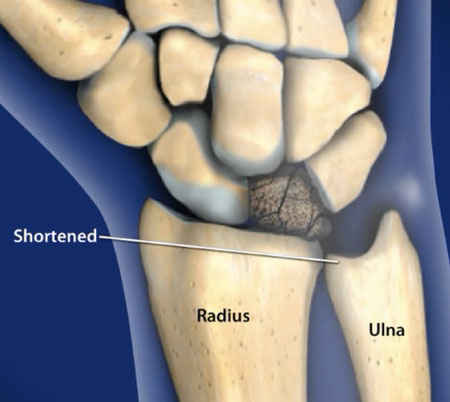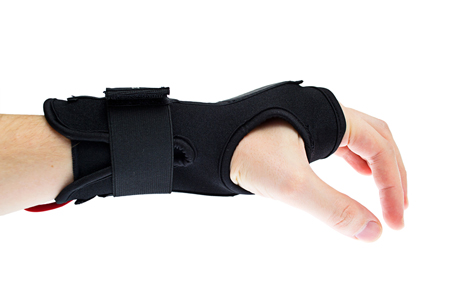Kienböck’s Disease
What is Kienbock’s Disease?
The wrist is a joint that connects the bones of the forearm to the hand. It composed of eight small carpal bones arranged in two rows of four. As with all living tissues in the body, bones require oxygenated blood for nourishment. If the blood supply is interrupted the bone could die in a process known as osteonecrosis. Kienbock’s Disease results from a reduction of blood flow to the lunate bone, the central bone in the wrist crucial for support and movement of the joint.

What causes Kienbock’s Disease?
The true cause of Kienbock’s Disease is unknown; however there are several risk factors for the condition. Trauma from a fall or blow to the wrist may disturb blood flow to the lunate. Usually two blood vessels provide blood flow to the lunate bone, but some individuals have only one source which reduces or slows the supply. Additionally, the difference in length of the two forearm bones (the radius and ulna) can ultimately place extra pressure on the lunate bone during various movements. The added stress may lead to Kienbock’s disease. Individuals with medical conditions such as sickle cell anemia, lupus, and cerebral palsy also have a higher incidence of Kienbock’s Disease.


What are the symptoms of Kienbock’s Disease?
Kienbock’s usually affects only one wrist and the primary symptoms include pain, stiffness, and reduced range of motion. The pain may vary in quality and duration and progressively worsen over time. Swelling and reduced grip strength may also occur.
Most patients go untreated for months or years. If left untreated the lunate bone may fragment or collapse. The abnormal lunate bone can wear away the ligament(s) making the wrist unstable and eventually resulting in Osteoarthritis.
How is Kienbock’s Disease diagnosed?
A detailed medical history and review of symptoms is the first step towards an accurate diagnosis. Kienbock’s is more difficult to diagnose in the early stages since the symptoms can mimic those of a sprained wrist. Imaging studies like MRIs and X-rays are extremely useful in diagnosis and staging of this disease.
How is Kienbock’s Disease treated?
Non-surgical
If caught early enough surgery can be avoided. Anti-Inflammatory medications such as ibuprofen can relieve pain and swelling. The wrist may need to be immobilized in a cast or splint for several weeks or months while healing occurs. If symptoms do not improve, surgical intervention may be required.

Surgical
There are several surgical treatment options available. Procedure choice will depend on various factors, particularly how advanced the disease has progressed.
- Revascularization returns blood flow to the lunate and is most successful in early stage of the condition.
- If the forearm bones are not the same length then Joint Leveling may be recommended. Bones are either made longer with grafts or shortened by removing a section in order to reduce stress on the lunate.
- Proximal Row Carpectomy is used in cases were the lunate is severely broken down. The lunate and the bones on each side are removed providing pain relief and maintaining some wrist movement.
- Partial or Full Fusion of the wrist bones may be required in the most advanced stages.
Early Stage:




Late Stage:



How can Dr. Knight help you with Kienböck’s Disease?
When it comes to rare and complex wrist issues like Kienböck’s, it is important to find a surgeon who is well-versed in their treatment and who has seen many cases. Dr. Knight is one such surgeon, and he will bring his expertise to bear in your case, which will, no doubt, lead to the restoration of function in your hand and wrist.
We’re looking forward to helping you live a more pain free life. To schedule an appointment with Dr. Knight, contact us online or give us a call at (855) 558-4263. With offices in Dallas, TX and Southlake, TX, we are able to serve the greater Dallas Fort-Worth area and surrounding communities, including Irvine, Arlington, Lewisville, Carrolton, and more.
Animated Videos
Surgical Video
Note: The following video contains graphic images.
(817) 382-6789
Disclaimer
HandAndWristInstitute.com does not offer medical advice. The information presented here is offered for informational purposes only. Read Disclaimer

























